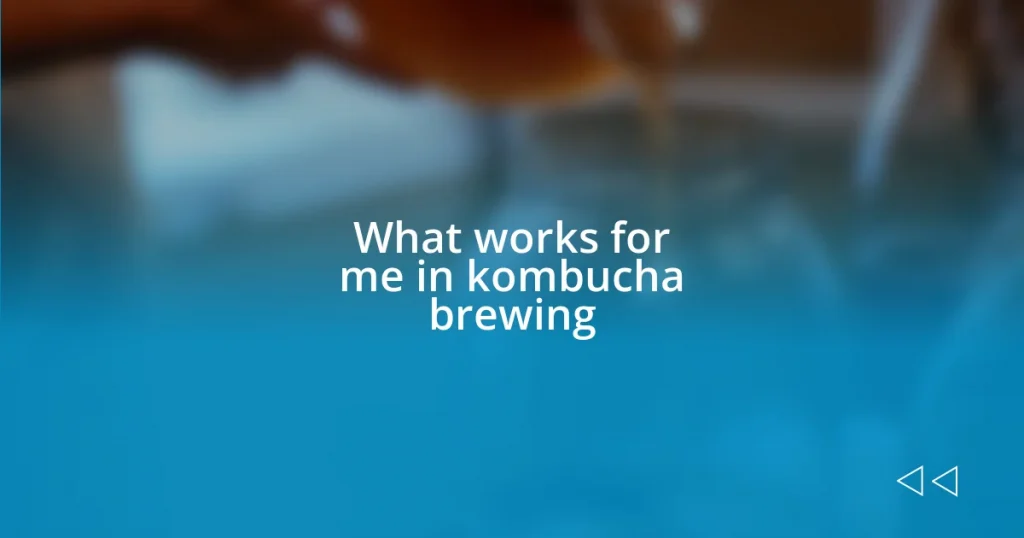Key takeaways:
- Kombucha requires four essential ingredients: tea, sugar, a SCOBY, and water, each playing a crucial role in fermentation and flavor.
- Temperature control, ideally between 74-78°F (23-26°C), is vital for successful fermentation; too high or low can negatively affect the brew.
- Monitoring fermentation time and experimenting with different sugars and flavorings can significantly enhance the kombucha experience, leading to unique and desired profiles.

Understanding kombucha ingredients
When I first started brewing kombucha, I was fascinated by the simple yet vital ingredients that make this fizzy drink come to life. At its core, kombucha comprises four ingredients: tea, sugar, a SCOBY (Symbiotic Culture of Bacteria and Yeast), and water. Have you ever considered how each component plays a role in the fermentation process? The tea provides the necessary nutrients for the SCOBY, while the sugar fuels fermentation, turning that sweet concoction into a tangy delight.
I remember my first batch of kombucha fondly. I used black tea, feeling adventurous, and let me tell you, the aroma that filled my kitchen was heavenly. The sugar dissolved effortlessly, almost like a gentle hug for the tea, as I embarked on this brewing journey. Each ingredient is interconnected, much like the community we create around our kombucha hobby. It’s thrilling to think that choosing different teas—from green to herbal—can completely change the flavor profile of your brew.
Water, often overlooked, is another crucial player in this symphony of fermentation. I experienced the difference firsthand when using filtered water versus straight from the tap. The clarity and purity of the flavor were unmistakable. It makes you wonder, doesn’t it? Just how much can water influence the final taste of your kombucha? Understanding and selecting your ingredients mindfully isn’t just about following a recipe; it’s about crafting an experience, one sip at a time.

Choosing the right tea
Choosing the right tea for your kombucha is like picking the perfect partner for a dance – each choice influences the flavor and fermentation process. I’ve experimented with various teas over the years and found that my favorites often yield the most unique and vibrant kombuchas. For instance, I remember the first time I brewed with oolong tea; the complex flavors danced on my palate and brought a whole new dimension to my brew, making it an instant hit during my friends’ tasting session.
Here are some popular tea options and their effects:
- Black tea: Provides a strong base with bold flavors and higher caffeine content.
- Green tea: Offers a lighter, fresher taste while contributing antioxidants that enhance the health benefits.
- Oolong tea: Combines characteristics of black and green tea, resulting in a complex flavor profile.
- White tea: Delicate and subtle, it produces a softer flavor with a hint of sweetness.
- Herbal tea: Great for caffeine-free options, but be careful; not all herbal teas work well with fermentation!
Choosing your tea intentionally can truly elevate your kombucha experience, so don’t hesitate to experiment and discover what resonates with your taste buds!

Selecting quality sugar types
Selecting the right type of sugar for your kombucha is essential, as it directly influences the fermentation process and final flavor profile of your brew. I’ve tried various sugar types throughout my brewing journey, from classic white sugar to more unique options like honey and turbinado sugar. Each type has its own characteristics, and I can say from experience, the sugar choice really matters. For instance, using raw cane sugar gave my kombucha a subtle caramel undertone that delighted my taste buds, while white sugar produced a cleaner, brighter flavor.
Another crucial aspect is the fermentation time, which can vary significantly with different sugars. I once brewed a batch with agave syrup, expecting it to offer a sweet, mellow taste. Instead, I found the fermentation process accelerated, leading to a tangier drink than anticipated. It’s fascinating how sugar types can affect not only flavor but also the speed of fermentation. This is why I recommend keeping a brewing journal to track your variations. Reflecting back on those entries has helped me refine my process.
Now let’s dive deeper into the types of sugars you can use with kombucha and what each brings to the table.
| Sugar Type | Flavor Profile |
|---|---|
| White Sugar | Clean, neutral flavor; ferments quickly. |
| Brown Sugar | Warm, molasses undertone; adds richness. |
| Raw Cane Sugar | Subtle caramel notes; slightly slower fermentation. |
| Honey | Floral notes; can vary widely based on the type. |
| Turbinado Sugar | Rich, earthy flavor; balances sweetness with depth. |
| Agave Syrup | Mellow sweetness; can ferment quickly. |

Importance of maintaining temperature
Maintaining the ideal temperature during kombucha fermentation is critical, and I’ve learned this the hard way. A few seasons back, I brewed a batch during a particularly chilly week and ended up with a sluggish fermentation process. The kombucha seemed to languish, refusing to reach that bubbly, tangy perfection I craved. It was frustrating to wait, knowing how easily temperature can shift the outcome; I found that temperatures around 74-78°F (23-26°C) yielded the most vibrant and lively brews for me.
Temperatures that are too low can stall fermentation, while excessively high temperatures can create an environment where unwanted bacteria thrive. After one summer brewing experiment, where my kombucha sat near an open window and overheated, I ended up with a batch that had an off-putting vinegar taste. This experience solidified my belief that consistent temperature control is crucial; it’s not just about getting it right; it’s about consistency in producing that perfect, effervescent drink every time.
I often use a simple digital thermometer to keep track, making it easy to monitor my brewing environment. Have you ever thought about how external conditions affect your food and drink? I know it may seem tedious, but understanding temperature’s role in fermentation has enriched my kombucha brewing experience immensely. It’s taken my kombucha from mediocre to magical, ensuring each sip reflects the care and attention I put into maintaining the perfect conditions.

Monitoring fermentation time
Monitoring fermentation time is a delicate balance that I’ve come to appreciate on my kombucha journey. There was one memorable batch where I miscalculated the fermentation duration, thinking it would benefit from an extra couple of days. The result? A brew so tangy that it sent my taste buds reeling! I learned firsthand that while longer fermentation can enhance tartness, there’s a fine line before it turns too vinegary for my liking.
I keep a close eye on fermentation time by tasting my brew every few days. This hands-on approach transformed my brewing routine into a rewarding ritual. Can you imagine the excitement of discovering a perfectly balanced flavor? It’s like a little party in your glass! I often jot down my findings in my brewing journal, noting how slight adjustments made a big difference. This practice has helped me gauge the right fermentation period for different sugar types, tailoring my kombucha to match my evolving palate.
Taking notes on fermentation time helps me avoid repeating past mistakes. For instance, my initial attempts often resulted in over-fermented batches that were unpalatable. Now, I aim for a sweet spot of about 7 to 14 days, depending on the season and my chosen sugar. Combining this knowledge with my tasting experiences enriches my connection to the brewing process, turning what once seemed like a chore into an adventure.

Bottling and flavoring techniques
Bottling your kombucha is both an art and a science, and it’s a stage I genuinely look forward to. When it comes to deciding on the right bottles, I prefer to use flip-top glass bottles because they enhance carbonation and keep the flavors locked in. I remember the first time I used them; after a few days, I cracked one open and was greeted by a delightful fizz that just made my heart sing. Have you ever experienced that satisfying pop when opening a bottle? It’s such a simple pleasure yet essential for the whole experience.
Flavoring is where my creativity really shines. I adore experimenting with fresh fruits and herbs as they can transform an ordinary brew into something extraordinary. One of my favorite combinations is ginger and peach, which gives the kombucha a refreshing spiciness with a sweet finish. Just last week, I crafted a batch by infusing sliced ginger and ripe peaches, and the results were incredible! The key is to allow the flavors to meld for at least two to three days during the second fermentation—trust me, this patience pays off with each delicious sip.
I’ve found that when I add flavors, the quantity matters more than you might think. My initial trials often involved tossing in too much fruit, leading to overpowering tastes. It wasn’t until I discovered the perfect balance—a cup of fruit per quart of kombucha—that everything clicked. Would you believe that experimenting led to such satisfying results? Balancing flavor intensity with the natural tang of kombucha has turned bottling into an enjoyable challenge that consistently leaves me excited for the next brew.

Troubleshooting common brewing issues
When it comes to addressing brewing issues, I’ve had my share of mishaps that taught me valuable lessons. One time, a batch of kombucha turned out unexpectedly flat. It was disheartening—after all that careful monitoring! I discovered that inadequate sugar during fermentation had stunted the fermentation process. Now, I always make sure to measure out the right amount, typically about one cup of sugar per gallon of tea, to ensure my brew gets that lovely fizz.
I also remember struggling with unwanted floaties in my kombucha, which at first made me uneasy. Was my SCOBY off? I learned that those fluffy strands are often just strands of yeast; they’re a normal part of the fermentation process. Now, instead of panicking, I embrace them as signs of a healthy brew. Have you ever noticed odd particles in your brew, only to realize they didn’t spell disaster? Recognizing these aspects of kombucha brewing has helped me grow more confident and patient with each batch.
A common concern I’ve heard from fellow brewers is the dreaded vinegar taste. One time, my batch ended up overly sour, and I couldn’t stomach it! I realized that the solution is simple: keep an eye on the fermentation time and temperatures. If I find myself losing track of how long it’s been brewing, a quick taste test serves as a reminder to stop the fermentation process by transferring it to the fridge. I often ask myself, “Is this the flavor I’m aiming for?” Listening to my taste buds has been a game-changer, making each brewing experience a little less daunting and a lot more enjoyable.
















